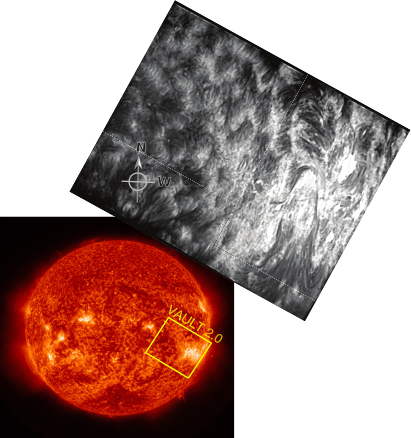Brief Description
The Very high Angular resolution ULtraviolet Telescope (VAULT) is an imaging spectroheliograph designed in the Naval Research Laboratory’s (NRL) Space Science Division as a sounding rocket payload and sponsored by NASA.

VAULT2.0 is the refurbished payload with new control and camera electronics and CCD detector. It acquires images at double the cadence of the original VAULT.
The payload was successfully launched on September 30, 2014 from the White Sands Missile Range. It obtained 33 images, 8 secs apart, of the Lyα atmosphere over active region 12172, as it was approaching the solar limb. The images captured light emitted from hydrogen atoms at temperatures of 8,000 to 100,000 degrees Kelvin.
A comprehensive database of observations from many space-based (IRIS, Hinode) and ground-based (BBSO, KPNO) telescopes was acquired as part of an observing campaign to support the VAULT2.0 launch.
The payload and first results are described in Vourlidas et al. (2016).
Data Products
This page provides access to a number of data products from the VAULT2.0 flight. More products will be added as the analysis of the VAULT and campaign data continues.
- VAULT2.0 data in FITS format.
The images have been co-aligned and their pointing determined by alignment to the AIA 304Å images. No dark current or other corrections have been applied. The files are also available from the SDAC archive and VSO. - VAULT2.0 data in map structure as an IDL save file.
A version rotated to solar north is also available. - Movies of the dark-subtracted frames in direct, unsharp-masked, and color.
- A comparison of VAULT Lyα and AIA 304Å subfields.
For questions and updates please contact: Solar-Researchnull@jhuapl.edu.
Data Policy
The data are publicly available per the VAULT2.0 Data Management Plan. If you use the data from this site, we would appreciate getting a copy of the publication and including the following acknowledgement:
"The VAULT2.0 project was funded by the NASA H-TiDeS program under NNG12WF67I."
Acknowledgements
The VAULT2.0 development was funded by the NASA H-TiDeS program under NNG12WF67I. The VAULT2.0 field team included: A. Vourlidas (PI), S. Tun-Beltran (Instrument Scientist; NRC Fellow), K. Eisenhower (Mech. Lead), Clarence Korendyke (Proj. Scientist), G. Chintzoglou (lab/mech. Support & data analysis; PhD student). The VAULT2.0 team at large included: R. Feldman (Flight Soft), J. Moser (Control Electronics), J. Shea (Camera Electronics), M. Johnson-Rambert (EE), D. McMullin (Proj. Mngt), E. Shepler (ME), and the late D. Roberts (EE). Many other people at NRL, NASA HQ, Wallops Flight Facility (WFF), and WSMR, contributed to the success of the project. We are especially thankful to the NSROC and WFF for their exemplary support. We thank all the instrument planners and operators for putting together a highly successful campaign.